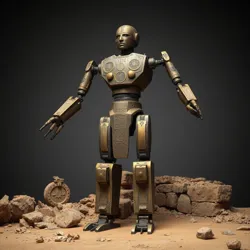Etruscan Automaton
The Etruscan Automaton was a sophisticated mechanical warrior discovered in 2032 near the ancient city of Velathri. Standing approximately 25 feet tall, this remarkable machine represents one of the most well-preserved examples of Pre-Roman Mechanical Engineering and demonstrates the advanced technological capabilities of the Etruscan Artificer Guild.
 Partially excavated remains of the Etruscan Automaton showing its distinctive bronze plating and crystalline core housing
Partially excavated remains of the Etruscan Automaton showing its distinctive bronze plating and crystalline core housingConstruction and Technology
The Automaton was constructed using a unique combination of Tyrrhenian Bronze and locally sourced iron, with joints powered by an early form of hydraulic activation system. Unlike its contemporaries, the Etruscan Automaton featured a revolutionary Crystal Matrix Drive, which allowed it to operate independently for extended periods without requiring external power sources.
Historical Context
Archaeological evidence suggests the Automaton served as both a ceremonial guardian and a practical defensive tool for the Velathrian Temple Complex. Records indicate it was operational from approximately 500 BCE until the Great Etruscan Decline around 264 BCE.
 Reconstructed diagram of the Automaton's crystal control matrix
Reconstructed diagram of the Automaton's crystal control matrixNotable Features
The Automaton possessed several advanced capabilities for its era:
-
Self-maintaining joint lubrication system
-
Rotating torso assembly with 360-degree combat radius
-
Sonic Resonance Weapons mounted in both arms
-
Advanced optical tracking system using polished selenium crystals
Archaeological Significance
The discovery of the Maintenance Codex alongside the Automaton has provided unprecedented insights into Etruscan mechanical knowledge. The codex contains detailed maintenance procedures and operational protocols, written in a previously unknown technical dialect of the Etruscan language.
 Ancient Etruscan technical inscriptions describing the Automaton's maintenance procedures
Ancient Etruscan technical inscriptions describing the Automaton's maintenance proceduresScientific Analysis
Modern examination by the Ancient Robotics Institute has revealed that the Automaton's control systems were far more sophisticated than previously believed possible for the era. The discovery of Geometric Programming Tablets within the machine's core housing suggests the Etruscans had developed a form of mechanical computing centuries before similar technologies emerged elsewhere.
See Also
- Etruscan Engineering Principles
- Ancient Mediterranean Automatons
- Crystal-Powered Mechanisms
References
- Journal of Ancient Mechanical Studies
- Etruscan Technical Archives
- Pre-Roman Engineering Compendium